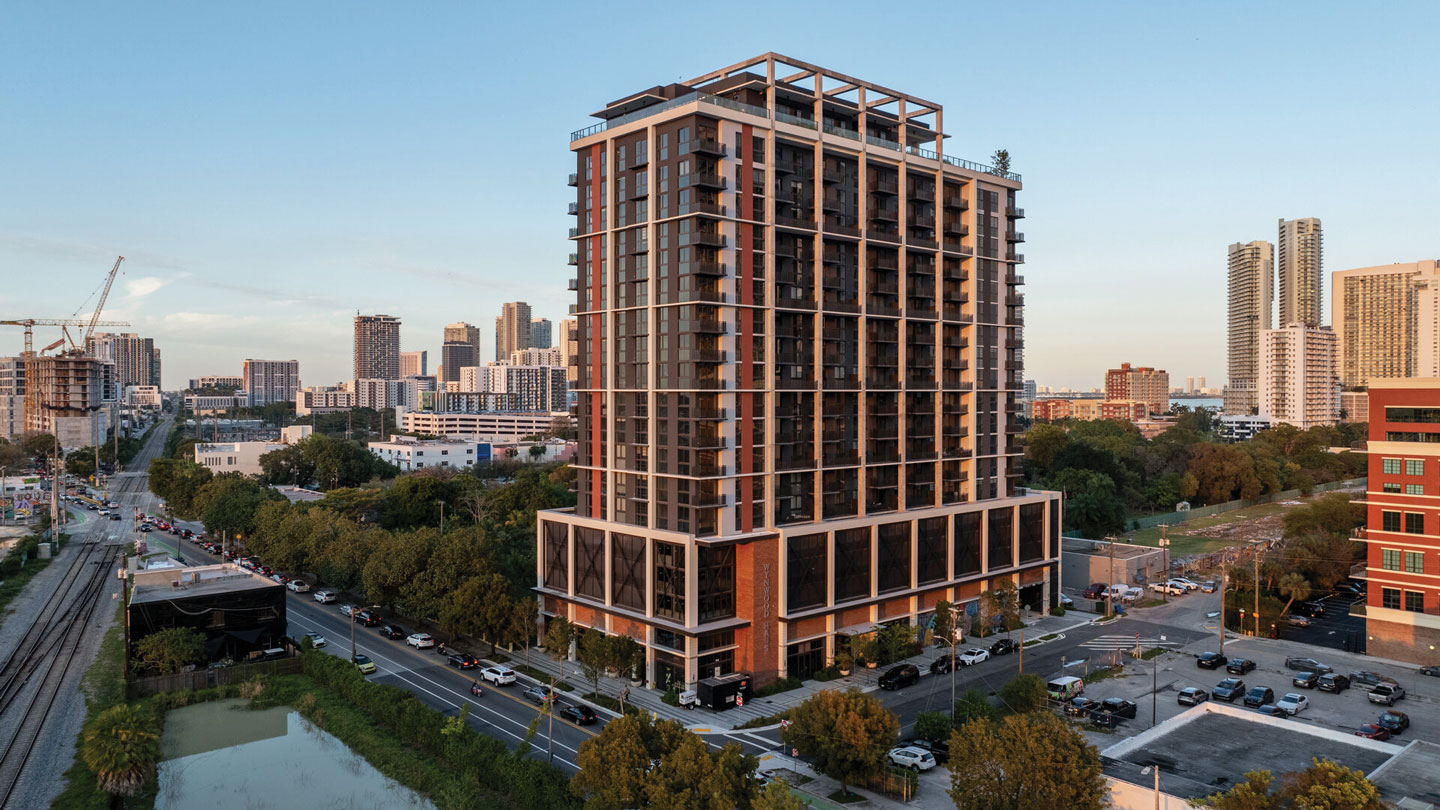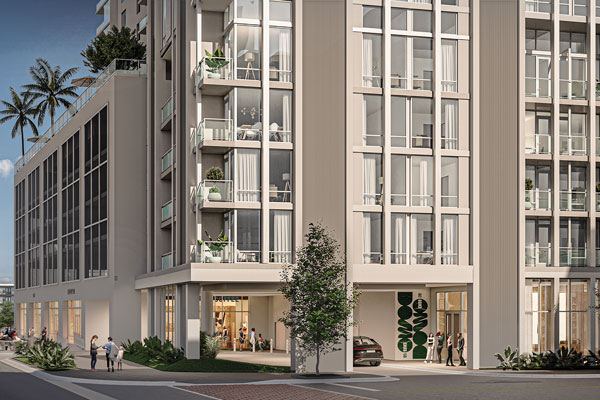
Shaping Florida’s Urban Future With Transit-oriented Development
The expansion of high-speed rail service across the state provides more options.
Florida, traditionally known for its car-dependent culture, is experiencing a significant surge in transit-oriented development (TOD). TOD promotes higher-density, mixed-use developments within walking distance of public transportation hubs, enhancing accessibility and reducing reliance on automobiles.
Several factors, including federal policy, land scarcity and evolving urban needs, are fueling this shift. The Infrastructure Investment and Jobs Act (IIJA), which allocated $90 billion for modernizing public transit systems, made transit-accessible developments increasingly attractive to residents and investors alike. Projects such as Wynwood Haus in Miami, 506 Datura in West Palm Beach, and DoMo at Cass Square in Tampa exemplify this trend, helping to raise standards for connectivity and sustainable living across the state. (It is not known at this time whether President Donald Trump’s executive order to stop disbursing IIJA funding is temporary or will become permanent. Regardless, it has added a layer of uncertainty and may impact investment going into TODs.)
Wynwood Haus utilized a conventional financing structure — an approximately 55% loan-to-cost construction loan from a lender, complemented by a limited investment partner, both attracted by the TOD model. A similar financial breakdown is anticipated for the projects in West Palm Beach and Tampa.
The Unlikely Rise of TOD in Florida
Despite limited mass transit options, Florida has embraced TOD as a practical response to rising congestion, increasing population density and a scarcity of developable land. Florida’s population has grown by over 1 million residents since 2020, reaching an estimated 22.6 million people as of April 2023, driven entirely by net migration. This influx is especially concentrated in urban counties like Miami-Dade, Broward, Palm Beach and Hillsborough, making them key areas for TOD initiatives. According to an INRIX Global Traffic Scorecard released earlier this year, Miami’s traffic increased 30% from 2021 to 2022, making it the eighth-worst city for traffic congestion in the world.
Brightline, the only privately owned and operated intercity railroad in the United States, serves these high-density regions. Projects near its high-speed rail stations are gaining traction as transportation becomes a critical factor in alleviating Florida’s congestion. Since Brightline’s expansion to Orlando in September 2023, ridership has grown significantly. In April 2024, Brightline reported carrying 223,117 passengers, a 48% increase from the prior April when its trains were not servicing Orlando, generating total revenues of $15.2 million. This growth illustrates a latent demand for transit options in Florida, suggesting residents are ready to accept alternative modes of transportation.
TOD Success Stories
LD&D, a Miami-based real estate development firm with more than $500 million in assets under management and a development pipeline of 1.25 million square feet, has put greater focus on TOD projects over the past several years.
Wynwood Haus, Miami
Developed by LD&D and real estate investment and development firm Black Salmon in partnership with Bridge Investment Group, Wynwood Haus exemplifies the benefits of TOD. Acquired in the first quarter of 2019 for $5.9 million, this project transformed previously undeveloped land into a modern multifamily residence, completed in December 2023.
Wynwood Haus appeals to renters seeking car-free urban living. It is located near the School Board Metromover Station, which saw an average of 1,247 weekday passengers in August 2024, a 4.2% increase from the previous year. The station also recorded significant growth in weekend ridership, with Saturday passengers up 11.4% year over year. Additionally, Wynwood Haus is connected to the Brightline rail service, offering residents quick access to Miami, Fort Lauderdale, West Palm Beach and Orlando.
The project features 224 units designed by Corwil Architects, with interiors by LD&D’s design division and landscaping by Enzo Enea. Amid an influx of approximately 900 new residents daily in Florida, Wynwood Haus caters to young professionals and families while incorporating workforce housing through incentives from Miami’s Omni Community Redevelopment Agency. All of the 100 workforce units are leased.
Wynwood Haus spans 297,492 square feet over 20 floors, along with 5,500 square feet of retail space. Given its proximity to transit options, the property commands some of the highest rents per square foot in the submarket, outperforming other centrally located projects burdened by traffic congestion. Rental prices start around $2,185 for studios, with two-bedroom units reaching up to $3,755. Amenities at Wynwood Haus include a rooftop deck featuring a pool and green space, along with a ground-floor coffee shop that enhances community engagement.
506 Datura, West Palm Beach
Located near the West Palm Beach Brightline Station on land parcels acquired in 2022 for $8.125 million, 506 Datura applies TOD principles to foster growth beyond major metropolitan centers. Brightline rail service provides direct regional access to cities like Boca Raton and Miami. The project benefits from a strategic collaboration with the city of West Palm Beach to upzone the property’s floor area ratio from 2.75 to 6.5 in exchange for a hospitality component. This partnership enhances the project’s anticipated value and positions the development, often referred to as the “welcome mat to West Palm Beach,” as a gateway to the city. The mixed-use development, scheduled to break ground this summer, will include 180 multifamily rental units, a 130-key hotel, and restaurants on the rooftop and ground floor.
The future success of 506 Datura should be supported by anticipated increased ridership at Brightline’s West Palm Beach station. In 2023, Brightline carried 2,053,893 passengers, marking a 67% increase from the previous year, with the West Palm Beach station alone accounting for 712,874 passengers during one reporting period. For 2024, Brightline reported a 40% increase in year-over-year passenger numbers overall. This surge in ridership aligns with the overall growth of Brightline, which is driven by rising demand for intercity travel options across Florida.
DoMo at Cass Square, Tampa
DoMo at Cass Square is strategically positioned to leverage its proximity to an Amtrak station and the future Tampa Brightline station, attracting residents who work in Orlando or at Disney but prefer living in Tampa. With rising demand for transit-accessible housing, DoMo caters to professionals seeking alternatives to long car commutes. LD&D acquired the 2-acre parcel for $10 million in April 2023, with plans to develop a $200 million mixed-use tower. Currently in development, the project is set to break ground this year. The 28-story luxury multifamily building will feature 360 apartments, 45,000 square feet of amenities and 32,500 square feet of ground-floor retail.
This development reflects the increasing demand for transit-adjacent housing options as Tampa’s urban core expands.
Challenges and Opportunities in Florida’s TOD Expansion
Despite the successes, Florida’s embrace of TOD faces significant challenges. Developable land near transit hubs is costly due to high demand for accessible locations, while local zoning requirements — particularly excessive parking mandates — limit the density essential for successful TOD projects.

DoMo at Cass Square is being developed near an Amtrak station and the future Tampa Brightline station, reflecting growing demand for transit-adjacent housing options in the Tampa metro area. Courtesy of LD&D
For example, Wynwood Haus was designed with a 1:1 parking ratio per unit, yet its average demand is only approximately 0.7 cars per unit — well below both its intended ratio and the norms for non-TOD developments. Although the project targeted a more aggressive 1:1 ratio, compared with the 1:1.25 or 1:1.5 ratios typical in other developments, smaller unit sizes have led to lower-than-anticipated parking demand. Even after maximizing every available deduction under the Miami 21 zoning code, mandated parking levels could not be further reduced due to the code’s parameters. This situation underscores the need for more flexible zoning policies that align with TOD realities.
Land ownership also plays a critical role in these developments. Properties like Wynwood Haus were often underutilized before redevelopment, making them ideal candidates for TOD. Strategic partnerships between public agencies and private developers help ensure that community needs are met while addressing market demands.
Despite these challenges, the shift toward TOD presents substantial opportunities. Advocating for reduced parking requirements and higher density allowances is essential for financial viability. As the demand for transit-oriented living grows, collaboration among developers, municipalities and transit systems will be vital for the future of urban development in Florida.
The Future of TOD in Florida
Florida’s experiment with TOD demonstrates that even car-centric regions can transition toward more sustainable urban development. Projects like Wynwood Haus, 506 Datura and DoMo are not just reshaping Florida’s urban landscape — they are also challenging long-held assumptions about transit and development in the state.
For developers, the ability to anticipate trends, engage with municipalities and adapt to changing urban dynamics is key to successfully navigating this emerging market. As Florida’s cities continue to grow and transit networks expand, TOD will play an increasingly important role in shaping the state’s future.
Diego Bonet is managing partner at LD&D.
Why Is TOD Gaining Traction in Florida Now?Several factors have converged to drive TOD in Florida: Federal policy: The federal government’s focus on modernizing transit systems accelerated TOD opportunities. It is difficult to predict how Trump administration policies may impact investment going into TODs. Land scarcity: As Florida’s population continues to grow, land near transit hubs becomes increasingly valuable. TOD offers a way to optimize these high-demand areas. Lifestyle shifts: Younger generations and professionals are embracing more sustainable lifestyles, favoring transit access over car ownership. While mass transit ridership in Florida remains modest compared to many other states, the growing presence of developments like Wynwood Haus, 506 Datura and DoMo suggests residents are ready to embrace transit-friendly living. As Brightline expands its reach, ridership around these projects is expected to increase, further cementing the value of TOD. |




